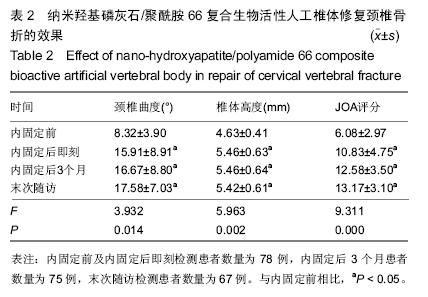中国组织工程研究 ›› 2016, Vol. 20 ›› Issue (3): 397-401.doi: 10.3969/j.issn.2095-4344.2016.03.017
• 纳米生物材料 nanobiomaterials • 上一篇 下一篇
纳米羟基磷灰石/聚酰胺66复合生物活性人工椎体修复前路颈椎骨折的应用
王高举,王 清,杨 进,王 松,钟德君,徐 双
- 四川医科大学附属第一医院脊柱外科,四川省泸州市 646000
Nano-hydroxyapatite/polyamide 66 composite vertebrae repair anterior cervical vertebral fractures
Wang Gao-ju, Wang Qing, Yang Jin, Wang Song, Zhong De-jun, Xu Shuang
- Department of Spine Surgery, the First Affiliated Hospital of Sichuan Medical University, Luzhou 646000, Sichuan Province, China
摘要:
文章快速阅读:
.jpg)
文题释义:
人工椎体:作为一类有效的椎体替代物在临床上得到广泛应用,有效恢复脊柱的生理解剖结构,其材料各异,有异体骨、陶瓷、金属等,选用应根据病变性质而不同。特点为:①既具有术后即刻稳定性,又兼顾长期稳定性,最好能与椎体形成永久骨性融合。②能充分恢复椎体的高度。③植入方便。④材料方面既要有良好的生物相容性,又应有较好的抗疲劳性能,在达到骨性融合前提供安全可靠的稳定性,又不影响MR检查。
羟基磷灰石:广泛存在于人体和动物正常硬组织中,如骨骼、牙齿等,同时也存在于人体的一些病态组织(如脑结石、尿路结石、扁桃体结石等)中。存在于自然骨中的磷灰石称为骨磷灰石。骨磷灰石是骨基质主要的无机成分,主要以晶体结构不完善的羟基磷灰石形式存在,其晶体为纳米级;而骨基质的主要有机成分为胶原。自然骨通过非常复杂的方式巧妙地将有机骨基质结构和无机骨盐框架结构互相紧密地结合起来,在人体中实现生物力学上的要求。
背景:纳米羟基磷灰石晶体在形态、尺寸、组成、结构和结晶度上与人骨羟基磷灰石晶体高度类似,其弹性模量与人体皮质骨相近,且具有良好的骨传导性、生物相容性、生物活性、更高的强度和韧性,因此纳米羟基磷灰石在医学领域的应用也日益广泛。
目的:评价纳米羟基磷灰石/聚酰胺66复合生物活性人工椎体在治疗颈椎骨折中的前柱重建的初期疗效。
方法:对78例四川医科大学附属第一医院脊柱外科颈椎骨折合并四肢瘫痪患者采用颈椎前路椎体次全切减压、植骨及纳米羟基磷灰石/聚酰胺66复合生物活性人工椎体内固定。
结果与结论:①所有患者均顺利完成手术,其中67例患者完成随访,X射线机MRI随访4-39个月,植入物无明显移位,颈椎生理序列及重建的椎体高度丢失少,内固定后脊髓功能有不同程度恢复。②结果提示纳米羟基磷灰石/聚酰胺66复合生物活性人工椎体应用于颈椎骨折前路手术可增大植骨融合面积,减少局部压强,防止植入体松动及下沉,有早期支撑稳定功能,可有效维持颈椎生理序列和椎间高度;内固定后植骨融合率高,便于用X射线片观察且不影响MRI扫描对脊髓的信号观察。
ORCID: 0000-0001-9507-9433(王高举)


.jpg)
.jpg)